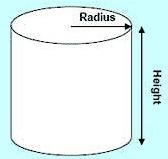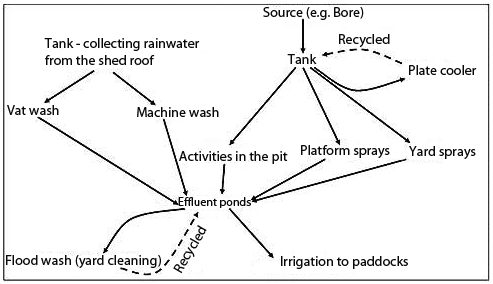Measuring water use in the dairy
Key points:
- Water used in the dairy is regarded as commercial use and requires a section 51 take and use license from the relevant water corporation.
- The quality and quantity of water required by each process in the dairy can vary.
- Understanding water flow through the dairy can help to identify areas where water can be reduced or reused.
The understanding of where and how much is used is essential to responsible water management on the farm. This requires the ability to measure it.
Water used in a dairy shed is considered a commercial use of water under the Water Act 1989. Any water used in the dairy sourced from a watercourse, dam capturing overland flow, spring or ground water (bore) requires a licence from the relevant water authority. Rain water captured from a roof, town water and any recycled or reused water is exempt and does not need to be licensed.
Knowing how much water is used helps with planning water needs, storage requirements and potential improvements to the security of supply, particularly during times of shortages. It can also be useful in identifying where water savings can be made.
An important consideration is using water suitable for the purpose. Understanding how water flows through the dairy shed can help identify points where water can be reused.
Processes in the dairy
There are a range of processes in the dairy, each requiring varying amounts of water of differing qualities:
- Vat and machine washing — Requires comparatively small volumes of the highest quality water, such as rainwater.
- Milk cooling — This can be the biggest use of water in the dairy if no recycling of the water occurs. However, when the water is recycled the net volume of water used in the plate cooler is very small. Requires high-quality water. The water can be recycled and continuously used for this purpose, providing there is a sufficient volume to ensure effective heat exchange.
- Pit activities and shed cleaning — Requires water of adequate quality for hosing down, but not necessarily as good a quality as rainwater. Generally, fresh or first use water needs to be used but recycled water from milk cooling could be used. Recycled effluent can not be used inside the shed for hygiene reasons.
- Platform sprays — Mainly associated with rotary dairies. Can require a large amount of water. Water quality needs to be similar to that for the pit activities and shed cleaning.
- Yard washing — Can account for a large proportion of the water used. Water does not necessarily need to be of a high quality and recycled liquid effluent may be used, which can save significant amounts of fresh water.
- Other (such as cooling sprays) — These often use comparatively small amounts of water, but can add up over a milking.
The processes that require large amounts of water, such as yard washing, milk cooling and fixed platform sprays are the areas where there is largest potential to save water through reuse and recycling.
Understanding how the water flows through the shed
Drawing the water flow helps to understand how water flows through the dairy (see Figure 1). This can also help determine where and how to measure the water use.
There may be multiple sources of water for the shed, including rainfall, bore water or dam water. From the source of water record each use for that water until it enters the dairy effluent system.
Figure 1 shows:
- Rainfall is used for vat and machine washing, which then flows into the effluent ponds.
- Effluent is then recycled for cleaning the yard with a floodwash tank.
- Bore water is also used in the shed, and is pumped to a tank, which is then used for the platecooler and then returns back to the tank.
- This water is then used for cleaning the platform (activities in the pit), yard and platform sprays on the rotary platform before draining into the effluent system.
- Dairy effluent is irrigated to pastures from the effluent pond.
Measuring water use in the dairy
There are 3 different methods of measuring water use in the dairy, depending on how the water flows through the dairy:
- tank method — this is appropriate where tanks are used to store water before dairy use
- flow rate method — only applicable if the tank method cannot be used
- meters — only a small proportion of dairies have meters installed, and these will only measure licensed water, which does not include rainfall from roofs
For the tank and flow rate method it is important to measure the daily water use during mid-lactation to give an average water use for the year. Each method will give reasonable approximation, but won't be absolutely accurate.
Tank method
Generally water use can be measured via this method if some or all of the water for use in the dairy comes out of tanks. You cannot use this method if the tank is filled during milking, such as from a bore.
Steps for each tank:
- List the processes that rely on this tank.
- Calculate the volume of the tank (skip to section).
- Either ensure the tank is completely full at the start of milking or at a known level.
- Turn off any taps to stock troughs. You must also remember to turn them back on at the end of milking.
- After milking determine the proportion of the tank used and calculate the volume of water used. Remember that different amounts of water may be used for morning and afternoon milkings, so measure both.
- Add the volumes for the morning and afternoon milkings to calculate the daily water use.
- Multiply the daily water use by the number of milking days per year (which is often 300 – 320 days).
- Record the volume for the processes that rely on this tank, in the running tally sheet (skip to section).
Calculating the volume of a tank
 Volume of tank = π × r² × h
Volume of tank = π × r² × h
Where:
- π (pi) = 3.14
- r = radius (half of the diameter in metres)
- h = height (in metres)
To convert volume (m³ or cubic metres) into litres (L), multiply the answer by 1000.
For example:
Radius (r) = 1.7 height (h) = 2.3
Volume of tank = 3.14 × (1.7)2 × 2.3
= 20.87m3 × 1000
= 20,870 litres
Flow rate method
The flow rate method will need to be used to determine the water use for each process, such as pit hose, yard hose and teat sprays, that is not supplied by a tank. It is important to work out the flow rate for each hose used, as they may vary substantially.
Steps for each hose:
- Time how long it takes to fill a suitably sized container of a known volume such as a 20 litre bucket or 100 litre cherry barrel.
- Divide the litre volume of the container by how long many seconds it took to fill to determine the flow rate (L/sec).
- Multiply by 60 (L/min).
- Determine how long each hose is used for the task per day and then multiply by how long per day each hose is used.
- Multiply by the number of milking days per year.
- Repeat these steps for all processes in the dairy.
- Record answers into the running tally sheet.
For more detailed information on the flow rate method and how to measure water used for milk cooling such as a plate cooler, see Dairy shed water usage.
Never try to measure the flow rate from a high volume or high pressure source such as hydrants, as they can deliver 2000 litres per minute and therefore can be dangerous and pose serious occupational health and safety risks.
The pump specifications can provide information on the flow rate for this type of equipment.
For a net volume used, be sure not to double count water (water that is reused or recycled from another part of dairy shed).
Running tally sheet
Table 1: Running tally sheet to calculate the total volume of water used in the dairy per year
Process water is used in | Water source(s) | Annual volume |
|---|---|---|
Yard cleaning | ML/yr | |
Milk cooling | ML/yr | |
Activities in the pit | ML/yr | |
Fixed cluster and platform sprays | ML/yr | |
Milking machine and bulk tank or vat cleaning | ML/yr | |
Other tasks (please specify) | ML/yr | |
Total volume in mega litres (ML) | ML/yr |
In some instances a combination of the described methods may be used. For example, if you use rainwater from a tank for plant wash, the tank method can be used to determine this volume and the flow rate method can be used to determine the volume used for all other processes.
Don't forget to include tasks such as cleaning calf-feeding equipment. These are small uses, but can add up over the year.
For more detailed information on measuring dairy shed water use, see Dairy shed water usage.
